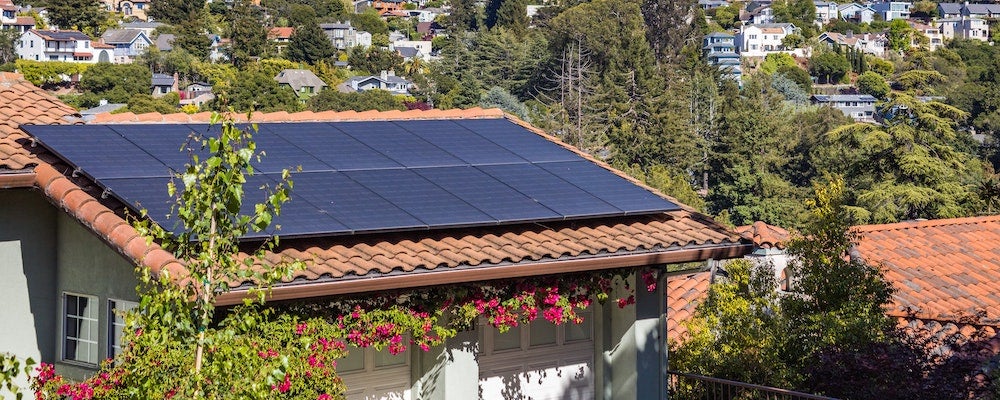
To determine whether your roof is a good candidate for solar, you need to know the answers to the following four questions:
- How many solar panels do I need?
- Does my roof have enough space for solar panels?
- What material is my roof made of?
- Will I need to replace my roof in the next 25 years?
This might sound like a lot to unpack on your own, but worry not! You will quickly learn how to tackle each of these questions and learn whether or not your roof is good for solar.
How many solar panels do I need?
Before determining whether your roof can accommodate solar, you need to know how much physical space the system will take up.
When figuring out how many solar panels you need, consider these three factors:
- Your energy usage: More energy consumption demands more panel space, more efficient panels, or more sunlight.
- How sunny your is roof: More sunlight means you can get away with fewer or less efficient panels.
- Solar panel efficiency: More efficient panels mean that you will need fewer of them because they are better at converting sunlight into energy relative to less efficient panels.
This article explains how to calculate how many solar panels you need by measuring each of these variables.
Once you arrive at the number of solar panels you need, you can finally estimate the square footage your solar energy system will occupy.
Take the typical solar panel size – 17.55 square feet – and multiply it by the number of solar panels you need. The result approximates how many square feet your solar system will take up.
For reference, a typical home in the United States needs 19 to 23 solar panels to cover its energy bills. That's between 335 and 405 square feet.
Therefore, a home requiring 19 to 23 solar panels needs at least 335 square feet of roof space.
How much space does my roof have?
A roof that can't fit panels is no good for solar.
Given a typical roof measures around 1,700 square feet and an ordinary solar system needs no more than 405 square feet, it would seem most roofs make the cut four times over.
Rarely can you take advantage of all of that real estate, however. Penetrations like chimneys, skylights, and vents obstruct solar panels. Additionally, panels can’t go across ridges and valleys, which further limits the usable space on your roof.
Solar panel systems also don't work as well without direct sunlight. Even if you have bountiful space, solar panels in shady areas or on a north-facing roof will produce less power.
Less-than-optimal sunlight won't take you out of the running for solar, but keep in mind that you may need more panels (and roof space) than your initial estimate.
How to measure your roof
The most accurate way to measure your roof entails climbing up there with a tape measure.
This roof estimate tool, which factors in skylights, vents, and dormers, delivers an accurate enough estimate for the cost of a roof replacement.
Once you take your measurements, compare the square footage figures between your roof and your solar system.
Your roof will suffice as long as you have more space than the estimated square footage your solar array will occupy.
If you have enough space, but the numbers seem too close for comfort, look to install high-efficiency solar panels. These panels produce more power per square foot, which means you can fit the system you need in a smaller area.
If you can’t make the space room for rooftop solar, consider ground-mount solar panels and community solar programs.
What is my roof made of?
Installing solar should present minimal risk to your roof integrity and warranty as long as you hire a solar company experienced with your particular roof material.
Despite this, some types of roofs work better than others for solar, typically because installation requires less time, complexity, or damage potential.
Since most contractors know how to install panels on asphalt shingles – the most common roofing material in the United States – the process is streamlined and the chances of costly mistakes diminish.
Solar on composite shingles can still lead to problems, however. Installation requires drilling holes through the shingles and into the rafters to fasten the solar mounts to the roof. If not flashed and sealed correctly, unwanted leaks and premature roof failure can occur.
For this reason, metal roofs, particularly standing seam, are the material of choice for solar. Installers don’t need to poke holes into the roof to fasten panel mounts. Instead, they use clamps or brackets to latch onto the seams. This both keeps the roofing membrane intact and speeds up the solar panel installation process.
Concrete, slate, and clay tiles, on the other hand, are less ideal for solar. For starters, the brittleness of these materials makes traversing atop and drilling into them a potentially destructive and costly affair.
The headaches and liabilities are partly why some solar installers avoid working on tile roofs. Once you locate a gung-ho installer, they must work slowly and deliberately to avoid damaging tiles, which only adds to costs.
The prospects arguably look the worst for wooden roofs, at least from a safety standpoint. Not only do wooden shakes easily split when walked on and drilled into, but they pose a fire hazard.
Solar panels seldom catch fire, but that risk, as minute as it is, justifiably ranks wood as the least ideal roofing material for solar.
Is my roof due for a replacement?
Since well-maintained solar panels can perform beyond 25 years, we recommend ensuring the underlying material will last at least as long.
You very well could replace a roof with solar panels installed. However, the process requires more time, money, and logistics than necessary. Installers essentially need to remove and re-install the system before and after the roofing job.
Imagine putting a brand new granite surface on top of shoddy kitchen counters. You could transfer the countertop over for when you inevitably replace the counters, but doing the full remodel first would have been far more time and cost-effective.
By preemptively replacing an aging roof before going solar, you avoid this nuisance and save in the long run.
This begs the question: how can you tell whether your roof is in good condition?
A professional roof inspection should provide a reliable answer. If you know when you had your roof installed, you can also subtract its age from its expected lifespan for a rough estimate.
Roofs with more than 25 years of life left get our seal of approval for solar. Should your roof show signs of age, know that you may face a more complicated and costly than necessary replacement down the road.
Is my roof suitable for solar panels?
In a time when the benefits of going solar, especially lower electricity bills, are too tempting to ignore, there are few compelling reasons to not go solar.
Having an unsuitable roof is one of them.
Therefore, homeowners should confirm whether their roof can house solar panels by defining their system size and how much viable space their roof offers.
Save yourself the reckoning by using our online solar calculator, which estimates your home’s solar potential based on your electric bill and geographic location.
With a firm grasp of your future solar savings, if or when to install a new roof is the final item to consider.
Key takeaways
- Determining whether solar will suit your roof comes down to solar potential. It's important to have a large enough roof to fit the amount of solar panels you need.
- Alternatives to roof solar include ground-mounted solar and community solar.
- Roofs with more than 25 years of life left are best for solar panels.
